
A 50MW/50MWh grid-scale battery energy storage system (BESS) will be used to demonstrate the ability of smart inverter technologies to support the stability of the power grid in Australia.
Broken Hill in New South Wales is a site with a strong history in the mining industry. More recently, it’s become host to solar and wind power generation.
Enjoy 12 months of exclusive analysis
- Regular insight and analysis of the industry’s biggest developments
- In-depth interviews with the industry’s leading figures
- Annual digital subscription to the PV Tech Power journal
- Discounts on Solar Media’s portfolio of events, in-person and virtual
However, the area has only a weak connection to the grid network. Renewable energy generated there is having to be curtailed when supply outweighs local demand and the variable nature of wind and solar is causing headaches for the local network’s managers.
The large-scale lithium-ion BESS will be equipped with grid-forming inverters which will improve system strength and allow for the greater integration of renewables. As highlighted in this recent Guest Blog for the site by Blair Reynolds at inverter manufacturer SMA, inverter-based technologies can play an important role previously played by thermal generation — creating synchronous inertia.
Major Australian utility company AGL is developing and will own the project, part of an 850MW BESS rollout it currently has underway.
Global energy storage system integrator and services company Fluence will provide the BESS, having signed a framework agreement to work with AGL in early 2021. Australian infrastructure services group Valmec will partner with Fluence on the project.
The AU$41 million (US$30.88 million) project will be supported with financing from the national Australian Renewable Energy Agency (ARENA), which this morning announced it will supply AU$14.84 million in funding.
ARENA, which is a government organisation, sees large-scale energy storage as a “key focus area” and the technology is a priority technology in the Australian government Technology Roadmap, ARENA CEO Darren Miller said.
“Big batteries are already becoming critical to our electricity system, but we know with grid forming inverters they can provide system strength services traditionally provided by thermal generation,” Miller said.
“We are particularly interested in seeing how AGL’s Broken Hill battery will utilise and demonstrate advanced inverter technology in a weaker section of the electricity grid.”
Darren Miller added that the project can highlight the potential of large-scale battery storage to provide system stability more cost-effectively as more renewable energy is added to the grid.
Broken Hill BESS is scheduled to be commissioned next year.
Also in development in the area is an advanced compressed air energy storage (A-CAES) project of 200MW/1,600MWh by Hydrostor, which has been selected by electricity network operator Transgrid to provide much larger-scale bulk storage at longer duration to directly ease curtailment issues and manage peak demand.
The announcement today comes a few days after AGL received local government approval for another major project in its BESS push, a 500MW/2,000MWh project planned for construction at a retiring coal power plant site, also in NSW.
How it works
“As Australia moves forward with its energy transition, we know that firming technologies like batteries play an important role in energy storage and supporting the energy supply,” AGL’s chief operating officer Markus Brokhof said.
“Broken Hill’s unique edge-of-grid environment provides an ideal location for this advanced inverter technology to demonstrate how it can facilitate further penetration of renewable energy generation and add to the stability of the wider electricity network.”
Thermal generation equipment, like coal and gas, are synchronous generation which provides stability to the electricity system through their continuous rotating mass while in operation.
While variable renewable energy sources are basically the opposite of that, inverters can instead play a corrective role and operate as the local network’s voltage source.
Australia got its first-ever BESS project that plays this role in 2018, in the Energy Storage for Commercial Renewable Integration (ESCRI) project at Dalrymple, South Australia, a similarly ‘edge-of-grid’ location. A 30MW/8MWh BESS supplied by Hitachi Energy (formerly Hitachi ABB Power Grids) serves as a provider of inertia at that demonstration project.
The Broken Hill system will be unique in that it will always stay in so-called grid-forming mode, inherently resisting changes in voltage and frequency on the grid and providing synthetic inertia through its Virtual Synchronous Machine (VSM) mode, Fluence said today.
The BESS will also perform more common applications such as participating in frequency control ancillary services (FCAS) markets and playing into other wholesale market opportunities in Australia’s National Electricity Market (NEM).
It could also assist the Australian Energy Market Operator (AEMO) by combining its capabilities with other inverter-based renewable energy assets nearby in the West Murray region of NSW.
“The Broken Hill battery project’s full power dispatches instantaneously to quickly respond to large changes in voltage and/or frequency, delivering the fastest response of all battery-based energy storage systems currently available in the market,” Fluence general manager for Australia Aaron McCann said.
“This fast response will enable the system to operate stably and damp voltage oscillations after a fault in weak grid areas the West Murray region, which will enhance the system strength on the grid.”
The grid-forming inverters themselves will be supplied by EPC Power, a California-headquartered manufacturer which was recently picked as power electronics supplier to EVLO Energy Storage, the energy storage system integrator subsidiary of Canadian utility HydroQuebec.






